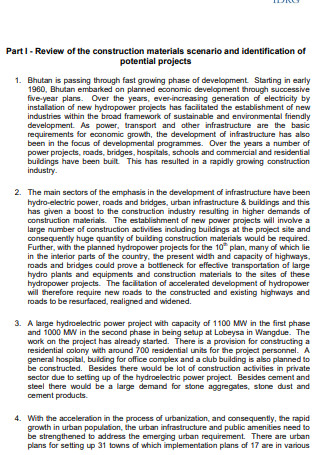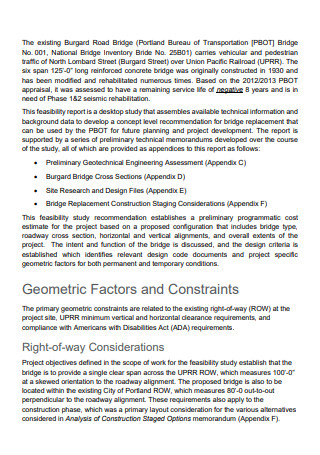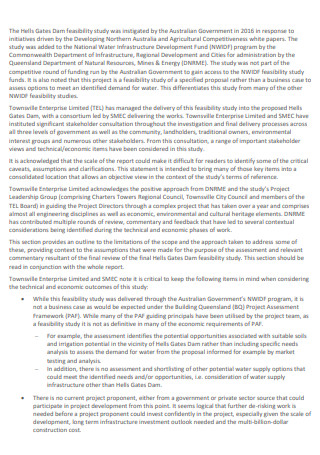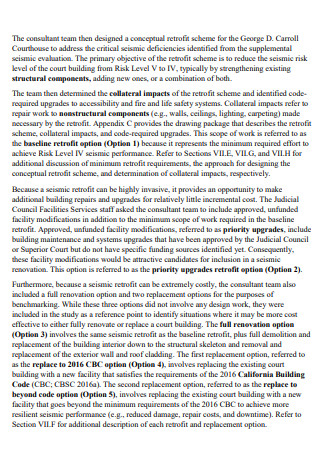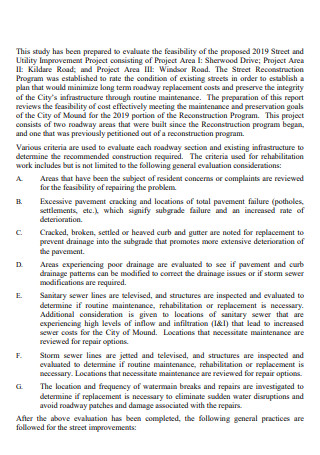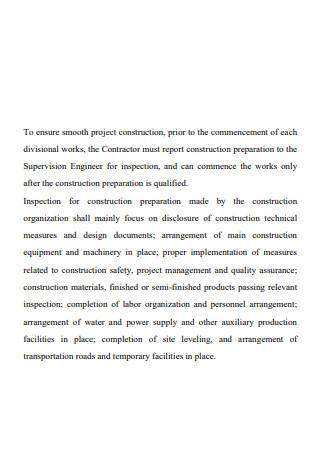5+ SAMPLE Construction Feasibility Report
FREE Construction Feasibility Report s to Download
What Is a Construction Feasibility Report?
A construction feasibility report is a report that analyzes the practicality and feasibility of a proposed construction project. It considers a variety of elements while determining the likelihood of success in developing it. As well as demonstrating how quickly the return on investment may be realized once the project is completed. It considers elements like construction costs, material availability, land topography, and location.
A construction feasibility report can also aid in the development of contingency plans for probable hazards and dangers. It’s excellent for evaluating the feasibility of starting the project in the first place. It could be beneficial to the construction bid and possible investors.
Purpose of a Construction Feasibility Report
Aside from evaluating the construction’s success percentage, a feasibility report serves other purposes. And these are critical variables to consider before construction can begin. Or even to begin work on an overall planning report. After all, planning can only be as accurate when all elements are considered. This makes it easy to plan for contingencies or map out the best feasible solution. To achieve the greatest possible result. And in construction, when expenses are substantial, a feasibility study is much more important.
Project Cost: Project costs are one element that influences project feasibility. Finding an investor may be difficult if the financial reports of expenditures and costs are extensive. Unless the possibility for return and profit is quite substantial. Structures take a long time to build. As a result, a significant shift in the economy or market could have an impact on its value. I it is preferable to include a profit and loss projection in the feasibility report. Most importantly, an estimate of the project’s cost. The report should also specify how and where the funds will be used. This is to aid in the creation of transparency and clear goals for the construction. And, as much as conceivable, generate an exact cost estimate. Assessing the Practicality of the Project: A construction feasibility report’s most evident function is to evaluate a project’s viability and practicality. To determine whether it is possible in the first place. And, most importantly, if there is anything to be gained from it. It doesn’t matter if it’s profit or another form of gain. It is done to persuade more investors. Simultaneously, to enhance the overall morale of everyone concerned. Before a barrier may form, it is critical to examine how various elements may contribute to its formation. The feasibility of constructing in the first place. For example, there could be legal limits that act as a roadblock and take a long time to resolve. Or a technological problem that would take too long to fix. And all of this screams “delay,” which is synonymous with squandered time and money. Return on Investment: It is critical for investors and business owners to understand when they can begin to generate money. Particularly for commercial buildings with higher complexities and subtleties. Because there are higher risks involved, they would prefer to receive a return on their investment as soon as feasible. It increases the risk for the investor, especially when significant sums of money are concerned. A construction feasibility study could determine when the project’s return on investment is likely to occur. And when the revenue could start accumulating. Ultimately, it boils down to risk and reward. It is not only important to know when, but also how much. These projections and statistics are critical to these persons. When they can identify where profit may be earned, they will be able to continue investing in ongoing projects. The economy and the market are additional elements considered in a feasibility report for a construction project. It examines the competition as well as the projected reception by its target population. These variables may have an impact on how quickly revenue begins to flow. Contingency Plan: Feasibility studies also reveal the weakest link in any construction project. That suggests there is a possibility that something will go wrong. That includes making plans for the worst-case scenario. Planning for each contingency helps to decrease loss when it occurs. It may also lessen the criticism from citizens and investors. The ability to control any probable scenario provides for a smooth functioning. Furthermore, contingency plans aid in the dissemination of knowledge to a greater number of personnel. That is, it would ensure more of their cooperation. Contingency plans also serve as a safety net, particularly in the event of a construction mishap. Or, alternatively, how to rebound quickly following a prospective loss. Or perhaps reduce the amount of time that is suspended. All of these scenarios result in financial losses and probable legal implications, which is bad for business. It can also have an impact on potential clients’ impressions. As well as putting those in charge through their paces. Gain Crucial Information: Only two things may be learned from the feasibility study report: potential strengths and drawbacks. Nonetheless, all this information is critical for the future. Because there is still more planning and time involved, things can be smoothed out beforehand. It can also assist direct strengths in the appropriate direction, where they can be used more effectively. As an example, consider the construction of a structure for a new franchise. Given that it already has a name and brand, it may use it to promote itself. It assures many customers even before it opens. It contributes to the security of the money on hand. It aids in more effective planning and covers shortcomings as needed.
Factors in Construction Projects
There are numerous elements to consider in a construction job. It aids in the creation of a cost estimate for the project. As well as assistance with planning. And all of these things contribute to a more accurate feasibility assessment. Let’s go over them in more detail below.
Availability of Local Materials: The cost of importing materials is high. However, there are additional fees and charges that are applied to the initial material cost. As a result, it is always more convenient to make materials locally. It’s less expensive and more convenient. Some materials, however, must be manufactured in other nations. Alternatively, parts must be shipped into the country. Furthermore, certain imported goods are better and more durable. As a result, when it comes to safety, a corporation may select for a foreign brand. And this is a significant consideration when it comes to construction costs. Because there is always a delivery fee and the hassle of organizing overseas purchases. It takes time and may necessitate adhering to local rules. Most construction sites will desire what is accessible in the local market. It’s always a good idea to investigate and evaluate where you can save money without sacrificing quality. Availability of Public Utility Service: It is always necessary to have access to public utilities in structures, especially residential buildings. It presents itself as water, heat, light, and other comparable things. These are essential in everyday life. It is also essential during the construction process. Materials must be blended; hence the availability of these resources is critical. And the people who will utilize the facility or a space within it must have continuous utility access. When those elements are present, it will be easier to sell or promote the place. This could entail obtaining permits or contacting the company that provides the services. Consider additional costs if certain services are not readily available. These are common commodities and necessities. And they may have an impact on the prospective profit from the building’s construction. It also has an impact on market feasibility. Population: Both the present population and the area’s population growth are crucial considerations. This is because these are the possible clients after the construction is completed. The demographics of the population, particularly in metropolitan areas, must be examined. When there is widespread interest in a market, it is easier to develop a target during the planning process. Population growth projections may also add to prospective revenue. If there is a clear migration away from the location, this would imply that customers are moving. Furthermore, the movement into the area would result in an increase in potential clients. The latter is especially true in cities. This would be fantastic news for investors. So, before you hammer the final nail in the coffin, take this issue into account for the feasibility study. Contour of the Land: The land itself can often be a major role in the success of a construction project in terms of its safety and viability. Some types of ground are either too soft or too hard to build on. However, with today’s engineering and technology, practically anything is conceivable. Nevertheless, it may have a significant impact on construction costs. It has the potential to take the construction in a whole new direction. It may cause some delays in getting the land ready for construction. It could imply incorporating modern, but costly, technologies. It may make the building easier or more complex to construct. As a result, it may have an impact on both the project timeline and the project costs. Furthermore, it may have an adverse influence on the areas around it. And its structural integrity will frequently be called into question. That is if the topographical investigation yields unfavorable results. Location: The placement of the structure is critical depending on its intended function after construction. Take, for example, manufacturing and supply factories. That could not reasonably be placed in the heart of the city. It could, but there would be more stringent regulations and a lot of noise from affected people and localities. Factories are extremely noisy and frequently run 24 hours a day, seven days a week. There could also be a problem with air pollution and waste management. It’s critical to consider how near you want to be to your market. The more crucial the position, the more likely it is to attract potential customers. It is always preferable to locate your building in an area that is both accessible and convenient. Just as the construction of bridges and skyways is always carefully planned. Its objective is to assist reduce traffic; hence its location must not have the opposite effect.
How To Write a Construction Feasibility Report
The goal of a feasibility study is to generate the most accurate and informative report possible. Since the report will be the basis for the majority, if not all, future judgments. The document’s discovery and conclusion would reveal the success rates and weaknesses of a proposed project. And writing one is a same ordeal.
-
Step 1: Conduct a Preliminary Analysis
It is recommended to undertake a preliminary feasibility analysis before drafting the report. This considers legal, financial, technical, economic, and scheduling considerations. And each of these elements could have an impact on the project’s viability. By taking these elements into account, a initial study would reveal whether there is a clear impediment. And identifying them early on would be beneficial before going on to a more complex issue. The preliminary research will also highlight common issues that may arise in the future.
-
Step 2: Projected Cost
A feasibility study’s goal is to report the expected cost. Especially in the construction industry, where materials can have a significant impact on the bottom line. First, determine whether the necessary supplies are available or can be obtained locally. Second, plan how it will be delivered and at what cost and quantity. Third, consider the labor cost. It is also a good idea to incorporate insurance for both workers and the construction itself as part of a contingency plan.
-
Step 3: Create a Timetable
A timeline can help everyone involved understand the project’s pacing and finish date. It also helps to improve the accuracy of the estimated cost. Since the cost of labor may be affected by the passage of time. And straying from the timeframe could result in a financial loss.
-
Step 4: Conduct a Research and Survey
It is critical to perform market research and consider how it may affect the surrounding environment. Whether before or after the structure’s construction. A poll could aid in predicting how the target market will react. It aids in narrowing down potential concerns that may arise from affected places and persons. The information gleaned from the study and survey will aid in plotting and illuminating the strengths and shortcomings of a project proposal.
-
Step 5: Analyze All Data
Analyzing and reviewing data assists in determining viable solutions for the construction project. It aids in determining which line of action will produce the best and most beneficial results.
-
Step 6: Write the Construction Feasibility Report
To begin drafting your report, you can utilize the above construction feasibility report template. Take the research facts into account and create a thorough documentation. It’s also a good idea to display a visual depiction of the data for better comprehension. Taking vital information into account to keep it brief and simple.
FAQS
Why Is it Important to Make a Construction Feasibility Report?
A feasibility report can assist in determining the success rate and viability of a project. In the long term, this helps to avoid delays and other financial losses.
What Elements Should Be Considered in a Construction Feasibility Report?
Legal, financial, technical, economic, and scheduling factors are all considered in every feasibility report. For construction projects, the topography of the site must also be considered. In addition to the challenges of skilled workers and cheap labor.
What Resources Are Required for a Construction Project?
There are resources that workers require and resources that workers use. They would, for example, require a living place with adequate accommodations and necessities. To operate, workers would require safety equipment as well as construction equipment. Materials such as concrete mix or steel must be arrange for the structure itself. They must also have access to sanitary and drinking water.
The feasibility of effectively constructing a building or structure is strongly dependent on the things that may affect it. A construction feasibility analysis could also be conducted before spending time and money. It is also one method of assuring and resolving any doubts concerning the construction. Do you have any reservations? Just have a look at the above sample construction feasibility report above!
